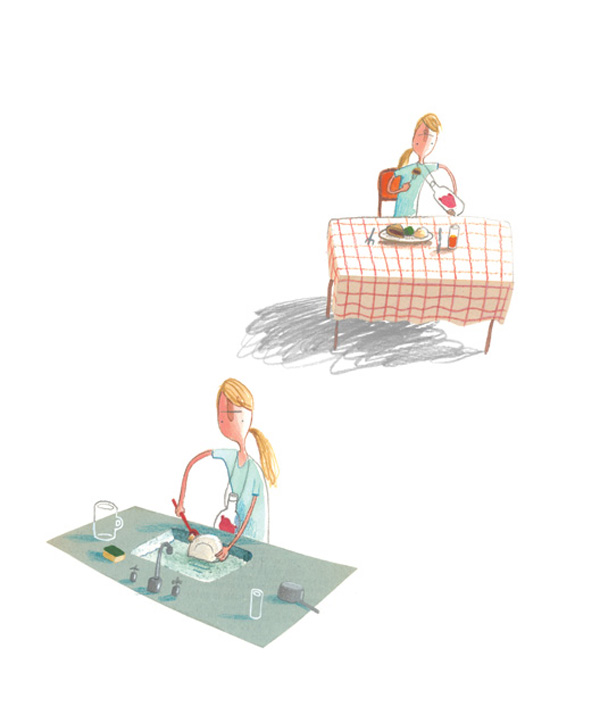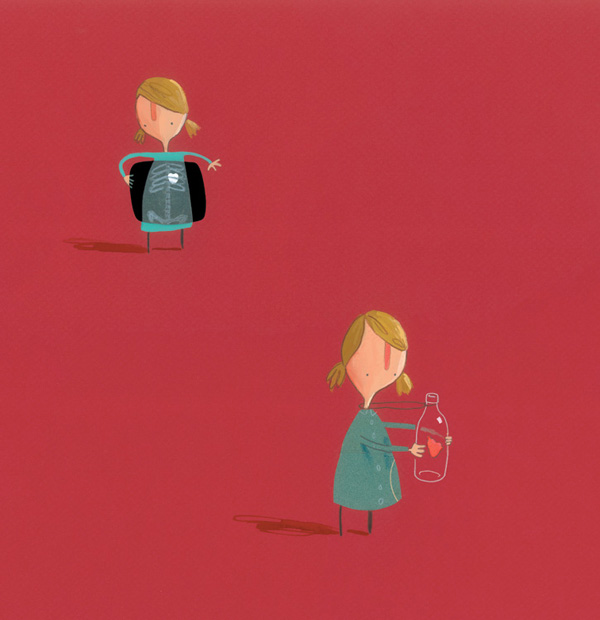Feeling unsure, the girl thought the best thing was to put her heart in a safe place.
Just for the time being.
So she put it in a bottle and hung it around her neck.
And that seemed to fix things … at first.
The above passage is from The Heart and the Bottle, written and illustrated by Oliver Jeffers. The picture book, which looks into how to make sense of death and loss, is now available in iTunes to buy and download as apps. The version is read by actress Helena Bonham Carter.
In the story, the girl, after losing her father. decided to protect her heart from hurting by putting it in a bottle around her neck. Of course, the problem with safeguarding her heart was that the girl no longer resembled her old exuberant, full-off-curiosity self. No more thinking about the stars or “the wonders of the sea,” she feels no pain, but also no happiness.
(Read previous post: “Ice Kachang Puppy Love”)

“She forgot about the stars… and stopped taking notice of the sea.
She was no longer filled with all the curiosities of the world and didn’t take much notice of anything…” (image credit: Oliver Jeffers/The Heart and the Bottle)
The “five stages of grief,” as introduced by psychiatrist Elisabeth Kübler-Ross, mentions the following: denial (this can’t be happening), anger (why is this happening), bargaining (make this not happen, and in return…), depression and finally acceptance. But here I propose Elizabeth Bishop’s villanelle: “One Art.”
Can loss become an art, to be practiced and perfected and somehow less painful?
The art of losing isn’t hard to master;
so many things seemed filled with the intent
to be lost that their loss is not disaster.
Thus begins the poem. The narrator tells you the art of losing isn’t hard to master because things are filled with the intent to be lost. Thinking to a lost sock or 2B pencil, you nod along, “Yes, the loss is insubstantial.”
Lose something everyday. Accept the fluster
of lost door keys, the hour badly spent.
The art of losing isn’t hard to master.Then practice losing farther, losing faster:
places, and names, and where it was you meant
to travel. None of these will bring disaster.
Although the narrator is still telling you that you can perfect the art of losing, as the loss grows more significant in the fourth tercet — I lost my mother’s watch. And look! My last, or next-to-last, of three loved houses went — you find yourself wavering in your conviction that practice makes losing perfect.
The ending quatrain:
– Even losing you (the joking voice, a gesture
I love) I shan’t have lied. it’s evident
the art of losing’s not too hard to master
though it may look like (Write it!) like disaster.
The shift from not hard to not too hard, as well as the forceful command “Write it!“, illustrate that loss, no matter how many times repeated, do not get easier with practice. But that’s okay. Because feeling sadness and happiness all that wonderful, yet different, mumble jumble of emotions is what living is about.
“Having problems means being alive,” wrote Ronald Pies, MD, editor in chief of Psychiatric Times, and likewise, having grief and sorrow and pain is also part of being alive.
In The Heart and the Bottle, the girl ultimately realizes that her heart does not belong in a bottle, but back in her body. Excitement, pleasure, romance, fear, sadness, you name it, let the heart jump up and down, flutter, cringe, get wrung and squeezed, and, just beat on.


Pingback: 人生功課:傷心,是一定要的 | 記者手扎